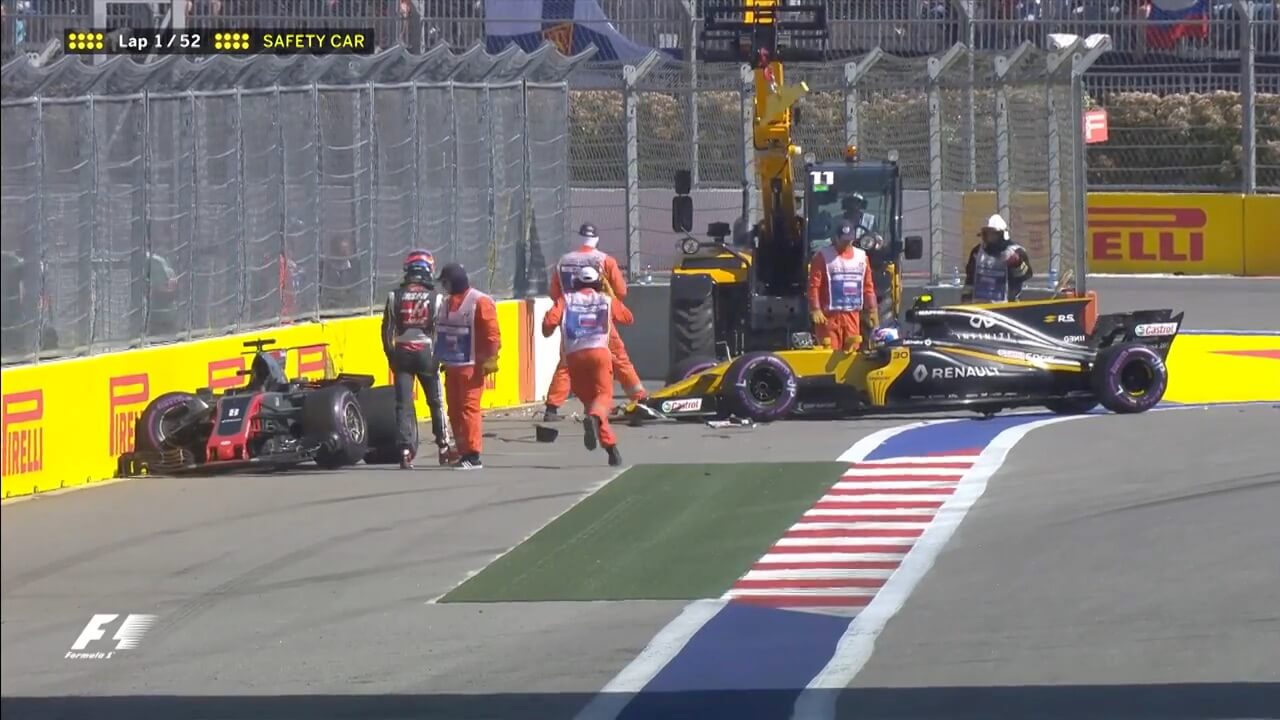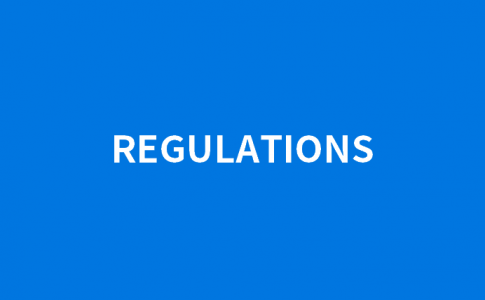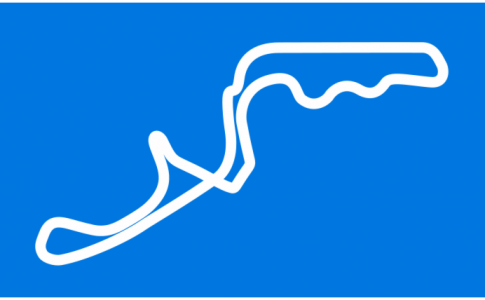2021年
2022年シーズンの内容については
こちらを参照ください。
モータースポーツでは、レース中にアクシデントやトラブルによってコース上やコース脇に車両がストップしてしまったり、突然の大雨などの悪天候の影響によって、安全にレースを行うことが困難になる状況が発生することがあります。
そのような場合でも、レースコントロールがレッドフラッグを提示してレースを中断するまでもないと判断した場合は、セーフティカー(SC)やバーチャル・セーフティカー(VSC)が導入されることがあります。
四輪モータースポーツにおける一般的なセーフティカーの運用ルールについてはこちらの記事を参照してください。
F1においても、他のレースカテゴリーと同様に、レース中にセーフティカーが導入される場合があります。
本記事では、2021年シーズンのF1におけるセーフティカーの運用ルールについて解説します。2021年シーズンのセーフティカー運用ルールは2020年シーズンから変更はありません。

出典:youtube.com
セーフティカーが導入されると
セーフティカーの導入が決定すると、コース脇にある全てのオブザベーションポストでイエローフラッグが振られ、同時に『SC』と書かれたボードが提示されます。この時点から、コース全域で追い越しが禁止されます。
F1ではデジタルフラッグにおいても『SC』の文字が点滅表示されます。
タイミングモニターや国際映像には『SAFETY CAR DEPLOYED』のメッセージが表示されます。
F1では、セーフティカー導入中の各車両の速度が監視されており、あらかじめFIAが設定した速度を超えないように走行しなければなりません。そのため、F1ではセーフティカーが導入されると、各車両が急にスローダウンする様子が分かるかと思います。
このセーフティカー導入中に守らなければならない速度を『デルタ』と呼ぶことがあります。

出典:youtube.com
セーフティカーによる先導走行
セーフティカーが導入されると、ピットロード出口から、セーフティカーがコースインします。セーフティカー導入中は、コース全域で追い越しが禁止されます。当然ですが、セーフティカーを追い越すことも禁止です。
セーフティカーの速度はコントロールされているため、自然とセーフティカーを先頭とした車両の隊列が形成されます。セーフティカーを先頭とした隊列走行を行なっている間に、コース上にストップした車両の回収作業を行ったり、大雨などの悪天候がおさまるのを待ったりします。

出典:youtube.com
セーフティカー導入中のピットストップ
F1ではセーフティカー導入中にピットストップを行うことが可能です。セーフティカー導入中はすべての車両が速度を落として走行しています。そのため、ピットストップ時のタイムロスが少なくなるため、セーフティカー導入中にピットストップを行う場合が多いです。
セーフティカー導入中にピットストップを行うことで、レース中のタイヤ交換義務を消化することはレース戦略のひとつです。予定よりも早めにピットストップを行うと、早めのタイヤ交換となるため、レース後半でタイヤが厳しくなります。
また、セーフティカー導入中に他の車両が一斉にピットストップを行う中で、ピットアウトをせずにそのまま走り続ける『ステイアウト』を選択する場合もあります。ステイアウトを選択する場合は、順位を大きく上げることができますが、タイヤ交換義務を消化していない場合は、セーフティカー解除後にどこかのタイミングでピットストップを行う必要があるため、その戦略はギャンブルと言えます。
セーフティカーの解除
セーフティカーの解除方法は国際モータースポーツ競技規則 付則H項に準拠しています。
コース上の危険な状況が解消されると、レースコントロールでは、セーフティカー解除の判断が行われます。セーフティカー解除の合図として、セーフティカーのオレンジの回転灯が消灯されます。これが、次の周回からレースが再開となる合図となります。
あわせてタイミングモニタには『SAFETY CAR IN THIS LAP』のメッセージが表示されます。セーフティカーの回転灯が消灯した後の隊列のペースは先頭車両がコントロールすることができます。
F1の場合、セーフティカーの回転灯が消灯される前に『SAFETY CAR IN THIS LAP』のメッセージが先に伝えられる場合があります。この場合、セーフティカーの回転灯が消灯するまで、セーフティカーを先頭とした隊列走行を継続する必要があります。
セーフティカーがピットロード入口にある第1セーフティカーラインを超えたら(ピットインしたら)、全てのオブザベーションポストで提示されていた『SC』ボードとイエローフラッグが撤去され、グリーンフラッグが振られます。これがレース再開の合図となります。
ただし、グリーンフラッグが振られて、セーフティカーが解除となっても、コントロールラインを通過するまでは追い越しが禁止されます。
バーチャル・セーフティカー (VSC)
F1ではセーフティカーを導入するほどではないけれども、コース上の特定の場所でダブルイエロー相当の大幅に減速をする必要があるとき、バーチャル・セーフティカー(VSC)が導入されます。
バーチャル・セーフティカーはF1で2015年から採用されています。
F1セーフティカー
F1では1996年からF1の公式セーフティカーを導入しています。1996年から2020年シーズンまでメルセデスベンツがF1の公式セーフティカーの供給を行ってきました。
詳細は発表されていませんが、2021年からメルセデスに加えて、アストンマーティンがF1の公式セーフティカーを供給する契約を締結したと言われています。全23戦のうち、半数のレースでアストンマーティンが供給するセーフティカーが配備されると言われています。
 出典:daimler.com
出典:daimler.com
F1セーフティカードライバー
F1の公式セーフティカードライバーは元DTMドライバーのベルント・マイランダー氏が務めています。
アーカイブ
























39) SAFETY CAR
39.1 The FIA safety car will be driven by an FIA appointed safety car driver and will carry an FIA safety car observer capable of recognising all the competing cars who is in permanent radio contact with race control.
39.2 Fifty minutes before the start of the formation lap the safety car will leave the pit lane and take up position at the front of the grid and remain there until the five (5) minute signal is given. At this point (except under Article 36.14(c)) it will cover a whole lap of the circuit and take up position.
39.3 The safety car may be brought into operation to neutralise a race upon the order of the clerk of the course.
It will be used only if Competitors or officials are in immediate physical danger on or near the track but the circumstances are not such as to necessitate suspending the race.
39.4 When the order is given to deploy the safety car the message “SAFETY CAR DEPLOYED” will be sent to all Competitors via the official messaging system, all FIA light panels will display “SC” and all marshal’s posts will display waved yellow flags and “SC” boards for the duration of the intervention.
39.5 No car may be driven unnecessarily slowly, erratically or in a manner which could be deemed potentially dangerous to other drivers or any other person at any time whilst the safety car is deployed. This will apply whether any such car is being driven on the track, the pit entry or the pit lane.
39.6 The safety car will join the track with its orange lights illuminated and will do so regardless of where the race leader is.
39.7 All competing cars must reduce speed and form up in line behind the safety car no more than ten car lengths apart. In order to ensure that drivers reduce speed sufficiently, from the time at which all Competitors have been sent the “SAFETY CAR DEPLOYED” message via the official messaging system until the time that each car crosses the first safety car line for the second time, drivers must stay above the minimum time set by the FIA ECU at least once in each marshalling sector and at both the first and second safety car lines (a marshalling sector is defined as the section of track between each of the FIA light panels).
The stewards may impose either of the penalties under Article 38.3a), b), c) or d) on any driver who fails to stay above the minimum time as required by the above.
39.8 With the exception of the cases listed under a) to h) below, no driver may overtake another car on the track, including the safety car, until he passes the Line (see Article 5.3) for the first time after the safety car has returned to the pits.
The exceptions are:
a) If a driver is signalled to do so from the safety car.
b) Under 36.14(c) or 39.12 below.
c) When entering the pits a driver may pass another car remaining on the track, including the safety car, after he has reached the first safety car line.
d) When leaving the pits a driver may overtake, or be overtaken by, another car on the track before he reaches the second safety car line.
e) When the safety car is returning to the pits it may be overtaken by cars on the track once it has reached the first safety car line.
f) Whilst in the pit entry, pit lane or pit exit a driver may overtake another car which is also in one of these three areas.
g) Any car stopping in its designated garage area whilst the safety car is using the pit lane (see 39.11 below) may be overtaken.
h) If any car slows with an obvious problem.
39.9 When ordered to do so by the clerk of the course the observer in the car will use a green light to signal to any cars between it and the race leader that they should pass. These cars will continue at reduced speed and without overtaking until they reach the line of cars behind the safety car.
39.10 Except under 39.12 below, the safety car shall be used at least until the leader is behind it and all remaining cars are lined up behind him.
Once behind the safety car, the race leader must keep within ten car lengths of it (except under Article 39.13 below).
39.11 Under certain circumstances the clerk of the course may ask the cars and the safety car to use the pit lane. In these cases, a signal to use the pit lane will be displayed before the start of the pit entry and all Competitors will be informed via the official messaging system, all cars must then enter the pit lane, drive through it and re-join the track. Any car entering the pit lane under these circumstances may however stop at its designated garage area. A penalty under Article 38.3(c) will be imposed on any driver who fails to enter the pit lane when required to do so.
Other than when the cars and the safety car are required to use the pit lane, no car may enter the pits whilst the safety car is deployed unless it is for the purpose of changing tyres.
39.12 If the clerk of the course considers it safe to do so, and the message “LAPPED CARS MAY NOW OVERTAKE” has been sent to all Competitors via the official messaging system, any cars that have been lapped by the leader will be required to pass the cars on the lead lap and the safety car.
This will only apply to cars that were lapped at the time they crossed the Line at the end of the lap during which they crossed the first Safety Car line for the second time after the safety car was deployed.
Having overtaken the cars on the lead lap and the safety car these cars should then proceed around the track at an appropriate speed, without overtaking, and make every effort to take up position at the back of the line of cars behind the safety car. Whilst they are overtaking, and in order to ensure this may be carried out safely, the cars on the lead lap must always stay on the racing line unless deviating from it is unavoidable. Unless the clerk of the course considers the presence of the safety car is still necessary, once the last lapped car has passed the leader the safety car will return to the pits at the end of the following lap.
If the clerk of the course considers track conditions are unsuitable for overtaking the message “OVERTAKING WILL NOT BE PERMITTED” will be sent to all Competitors via the official messaging system.
39.13 When the clerk of the course decides it is safe to call in the safety car the message “SAFETY CAR IN THIS LAP” will be sent to all Competitors via the official messaging system and the car’s orange lights will be extinguished. This will be the signal to the Competitors and drivers that it will be entering the pit lane at the end of that lap.
At this point the first car in line behind the safety car may dictate the pace and, if necessary, fall more than ten car lengths behind it.
In order to avoid the likelihood of accidents before the safety car returns to the pits, from the point at which the lights on the car are turned out drivers must proceed at a pace which involves no erratic acceleration or braking nor any other manoeuvre which is likely to endanger other drivers or impede the restart.
As the safety car is approaching the pit entry the SC boards will be withdrawn and, other than on the last lap of the race, as the leader approaches the Line the yellow flags will be withdrawn and a green flag will be displayed at the Line.
39.14 Each lap completed while the safety car is deployed will be counted as a race lap. However, if the procedure set out in Article 36.14(c) is followed Article 5.3(c) will apply.
39.15 If the safety car is still deployed at the beginning of the last lap, or is deployed during the last lap, it will enter the pit lane at the end of the lap and the cars will take the end-of-race signal as normal without overtaking.